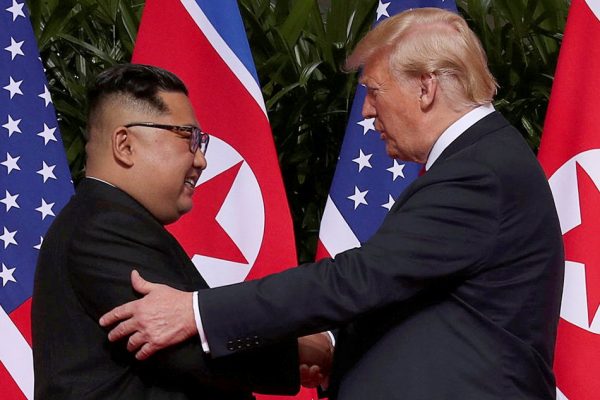
For Kim Jong Un, this moment is vindication. The wisdom of his nuclear policy has been confirmed: His tiny, poor, often hungry country, where hundreds of thousands have perished in concentration camps that differ little from those built by Stalin, has been treated as the equal of the United States of America. If Kim hadn’t continued the missile program, if he hadn’t enhanced his missile delivery capability, President Trump would not be there.
The photographs will also help Kim solve an important problem. All dictators are insecure, and absolute dictators are absolutely more insecure than the rest. Several years ago, Kim staged the elaborate murder of his uncle, forcing the rest of the elite to watch as his rival was ripped apart by antiaircraft machine guns. Fear and terror are one way to transmit messages of power; the inspiration of admiration and awe are another. The flags and the handshake will reinforce Kim’s legitimacy and make him harder to depose.
For Trump, this image addresses the somewhat different problem of his personal feelings of insecurity. Legally, his legitimacy is not in doubt. Yet Trump often seems to worry that it is. Elected without a majority, Trump repeatedly claims he has one. With no political, educational or any other qualifications, Trump ascribes to himself almost mystical, intuitive qualities instead. So far, these have failed him. In the complicated, nuanced worlds of economics and security, he has achieved nothing except destruction: of previous agreements, of institutions, even of an anodyne G-7 statement just days ago. But in Singapore, he could achieve something without discussion of complex issues, without any intellectual effort at all: a photograph, a “breakthrough,” the image of the intuitive dealmaker who wants “peace.”
The images coming out of Singapore are also important to Trump because he has created them. When meeting with allies, Trump does not control the narrative, nor does he decide what people will see. Indeed, the image that came to symbolize that disastrous, angry G-7 meeting was not his own creation: It was taken by a German photographer, and it showed Chancellor Angela Merkel leaning over a table and talking down to the American president, like a parent to a child. In Singapore, by contrast, Trump controlled the optics, even deliberately giving priority to a Singaporean television station rather than the White House pool. He reveled in that ability. “Are you getting a nice photo,” he actually asked the camera operator, “So we look nice and handsome and beautiful and perfect?” As for the substance of the meeting, there wasn’t any. The paper signed reiterates previous vague agreements. It promises “denuclearization,” just as in the past, but without any substance, as in the past. It implies that there will now be further talks about talks, but there have been U.S.-North Korean talks before. Had any previous American president, Republican or Democrat, emerged from an event like this, in which so much was given away with so little to show for it, he would have been embarrassed and probably vilified.
But Trump and Kim are two men who survive, in politics, by insisting on their own versions of reality. Both have propaganda machines which will trumpet a great success. Both will be loudly applauded by their respective supporters. Both will gain personally, even if their countries don’t. In that sense, this was indeed, as Trump said, “a really fantastic meeting.”
Leave a Reply
You must be logged in to post a comment.